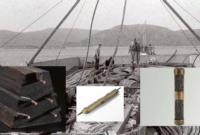
Introduction:
The Cable Telegraph stands as a transformative innovation that revolutionized long-distance communication during the 19th century. This technology enabled the transmission of messages across vast distances via underwater cables, reshaping global connectivity.
The Cable Telegraph represents a monumental advancement in global communication during the 19th century, facilitating the transmission of messages across oceans via underwater cables. Its implementation revolutionized intercontinental communication and marked a significant milestone in the history of telegraphy.
Historical Context:
The development of the Cable Telegraph emerged as a response to the need for faster and more reliable communication networks, supplementing existing telegraphic systems. It represented a significant leap forward in transcontinental communication.
Development and Operational Mechanisms:
The Cable Telegraph utilized underwater cables, laid across oceans, to transmit electrical signals. These cables, made of insulated copper or other conductive materials, facilitated the transmission of messages through electrical impulses.
The Cable Telegraph operated by utilizing insulated copper or conductive materials encased in protective layers, forming underwater cables laid across seabeds. Electrical signals were transmitted through these cables, allowing messages to traverse long distances beneath the ocean.
Key Components and Functionality:
Underwater Cables: Insulated conductive cables laid across sea beds to transmit electrical signals across continents.
Transmitting and Receiving Stations: Locations at both ends of the cable system where messages were sent and received.
Stations situated at either end of the cable system where messages were sent, received, and decoded.
Electrical Signaling: Electrical impulses were sent through the cables, interpreted and decoded at receiving stations to convey messages.
Advantages and Impact:
The Cable Telegraph brought about a revolution in transcontinental communication, significantly reducing the time required to transmit messages across continents. It facilitated rapid communication between distant locations, impacting commerce, diplomacy, and news dissemination, accelerating global interconnectedness.
Notable Advancements and Pioneers:
Pioneers such as Cyrus West Field played instrumental roles in the development and implementation of the Cable Telegraph. Their perseverance and technological innovations led to successful cable laying expeditions across oceans, connecting continents and enabling transoceanic communication.
Visionaries like Cyrus West Field and Sir Charles Bright made pioneering contributions to the development and successful implementation of the Cable Telegraph. Their perseverance, innovative designs, and successful cable laying expeditions across oceans played instrumental roles in connecting continents and enabling transoceanic communication.
Legacy and Transition:
The Cable Telegraph marked a pivotal shift in long-distance communication, laying the foundation for future advancements in global connectivity. While subsequent technologies like wireless communication and the internet eventually superseded it, the Cable Telegraph’s legacy endures as a vital milestone in the evolution of telecommunications, highlighting the transformative power of transoceanic cables.
Conclusion:
The Cable Telegraph remains a testament to human ingenuity in establishing transcontinental communication networks. Its utilization of underwater cables facilitated rapid and reliable messaging across continents, impacting global connectivity. Despite being surpassed by later technologies, the Cable Telegraph’s legacy persists as a crucial step in the history of telecommunications, underlining the significance of submarine cables in the evolution of global communication.
Understanding the significance of the Cable Telegraph provides valuable insight into the relentless pursuit of faster and more reliable communication methods, shaping the interconnected world we inhabit today.
